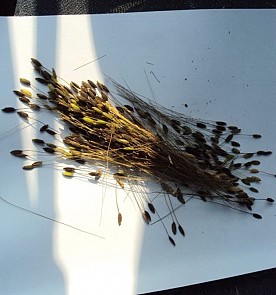‘Ghost rice,’ or ‘God rice,’ is a species of wild rice mainly found in the Mekong Delta, that has been the focus of study after Japanese researchers discovered that it carries a precious gene.
It has been considered ‘a great discovery’ by the Japanese, since it can help create a breakthrough in the heredity and selection of rice varieties, according to Professor and Doctor Nguyen Thi Lang from the Mekong Delta Rice Institute.
The wild species has many dominant characteristics in its resistance against diseases, harsh climatic conditions, and overall survival.
It has survived for millions of years regardless of drought, flood, poor water quality and disease.
Why is it called ‘ghost rice’?
Each grain of ‘ghost rice’ has a very long tail, around three centimeters in length.
The grain of the wild species is around four millimeters long while the grain of normal rice is 6-7.5 millimeters.
Thanks to its long tail, it is not hunted by the herbivorous bird or mouse because the tail makes it impossible for these animals to swallow.
In addition, grains of ‘ghost rice’ can keep themselves in ‘standby’ status for years, be it in soil or underwater, and then sprout under suitable natural conditions.
Once grown into an adult rice plant, it can grow between 20 and 30cm in one night so as not to become submerged in rising floodwater.
“Generally, a ‘ghost rice’ plant will grow to the point where floodwater reaches, even within a night,” said farmer Tran Van Luong in the Mekong Delta province of Dong Thap.
Luong told Tuoi Tre (Youth) newspaper that he had harvested ‘ghost rice’ for food over a ten year period of poverty during the 1970s and 1980s.
“In short, I see that this species of ‘ghost rice’ has some characteristics that are as odd as (a) ghost,” Luong joked.
A notable feature of the wild rice species is that ripe grains always fall off the stem to the ground before the sun rises.
So, farmers who reap ghost rice must start their job in darkness, often at 2:00 am or 3:00 am before returning home in the twilight.
It is another reason for people to call it ‘ghost rice.’
Today in the Mekong Delta, it is easy to find bushes of ‘ghost rice’ growing by the banks of rivers, canals and ponds, or in gardens.
Three years ago, a group of Japanese researchers came to the region to search for and collect DNA samples of ‘ghost rice’ for study.
Recently they have announced the initial results of that study on the samples they collected by the bank of the Bao Dinh River near My Tho Market in Tien Giang Province, and in a garden in Can Tho City.
The species carry a very precious gene, but what it is exactly needs more time for cross examination, according to the result.
Ancestors of modern rice species
Prof. Lang from the Mekong Delta Rice Institute said Vietnam has four species of ‘ghost rice’ with the common scientific name of Oryza, including Oryza officinalis, Oryza rufipogon, Oryza nivara, and Oryza granulata.
The last one, Oryza granulata, is found only in Muong Te District of the northwestern province of Lai Chau, but has otherwise become extinct in nature.
However, its genes have been kept at the Mekong Delta Rice Institute, Prof. Lang said.
There are a total of 26 species of wild rice found all over the world, she added.
‘Ghost rice’ grains ripen once a year, in November.
Previously, ‘ghost rice’ grew well in the Tram Chim National Park in Dong Thap, but it has gradually decreased in quantity for unknown reasons.
Doctor Duong Van Ni, an expert in biodiversity from Can Tho University, located in Can Tho City, said at an acid sulphate level of under three, no grain of any plant can sprout, while ‘ghost rice’ grains can.
After the first rains of any rainy season, the acid sulphat level in soil and floodwater in the Mekong Delta is high and ‘ghost rice’ grains begin developing and striking their roots deep into soil in preparation for the coming flood season.
When floodwater rises, ‘ghost rice’ plants can shoot up an average of 10cm a day to stay ahead of the rising water, Dr. Ni explained.
‘Ghost rice’ in the Mekong Delta blossoms spectacularly in late October, while its grains can ripen within ten days after blossom.
New grains will fall off the stem and lie in the soil in preparation for favorable, natural conditions to start the life cycle all over again.























































